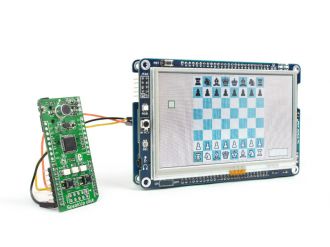
We strongly encourage users to use Package manager for sharing their code on Libstock website, because it boosts your efficiency and leaves the end user with no room for error. [more info]

Rating:
Author: MIKROE
Last Updated: 2014-07-25
Package Version: 1.0.0.0
Category: Gaming and Fun
Downloaded: 863 times
Not followed.
License: MIT license
We challenge you to beat an STM32 it in a blitz game. Our chief of software can do it fairly consistently. How well will you fare? You can use the SpeakUp to speak out your moves while you skim a book on chess openings.
Do you want to subscribe in order to receive notifications regarding "mikromedia plus for STM32 and SpeakUp Chess" changes.
Do you want to unsubscribe in order to stop receiving notifications regarding "mikromedia plus for STM32 and SpeakUp Chess" changes.
Do you want to report abuse regarding "mikromedia plus for STM32 and SpeakUp Chess".
| DOWNLOAD LINK | RELATED COMPILER | CONTAINS |
|---|---|---|
| 1406274295_mikromedia_plus__mikroc_arm.zip [329.76KB] | mikroC PRO for ARM |
|

MM+ STM32 and SpeakUp connections.
View full imageChallenge the MCU on your mikromedia plus for STM32 to a game of chess. The game is adapted from the Fairy-Max chess engine. You can also pair it with SpeakUp click and speak your moves. You'll need a shield for your mikromedia and a set of wire jumpers to do that. It's a simple setup because the commands are sent over UART indexes.
Just record columns (best to use a phonetic alphabet like Alpha, Bravo, Charlie and so forth) followed by rows (1-8). So you'll start with Index 0 in the SpeakUp software and record "Alpha", and end with Index 15 and a recording of "eight". See how it works in the video. It plays quite good considering it's a single MCU with no additional memory. Try and beat it. Or try tinkering with the code to make it even stronger.